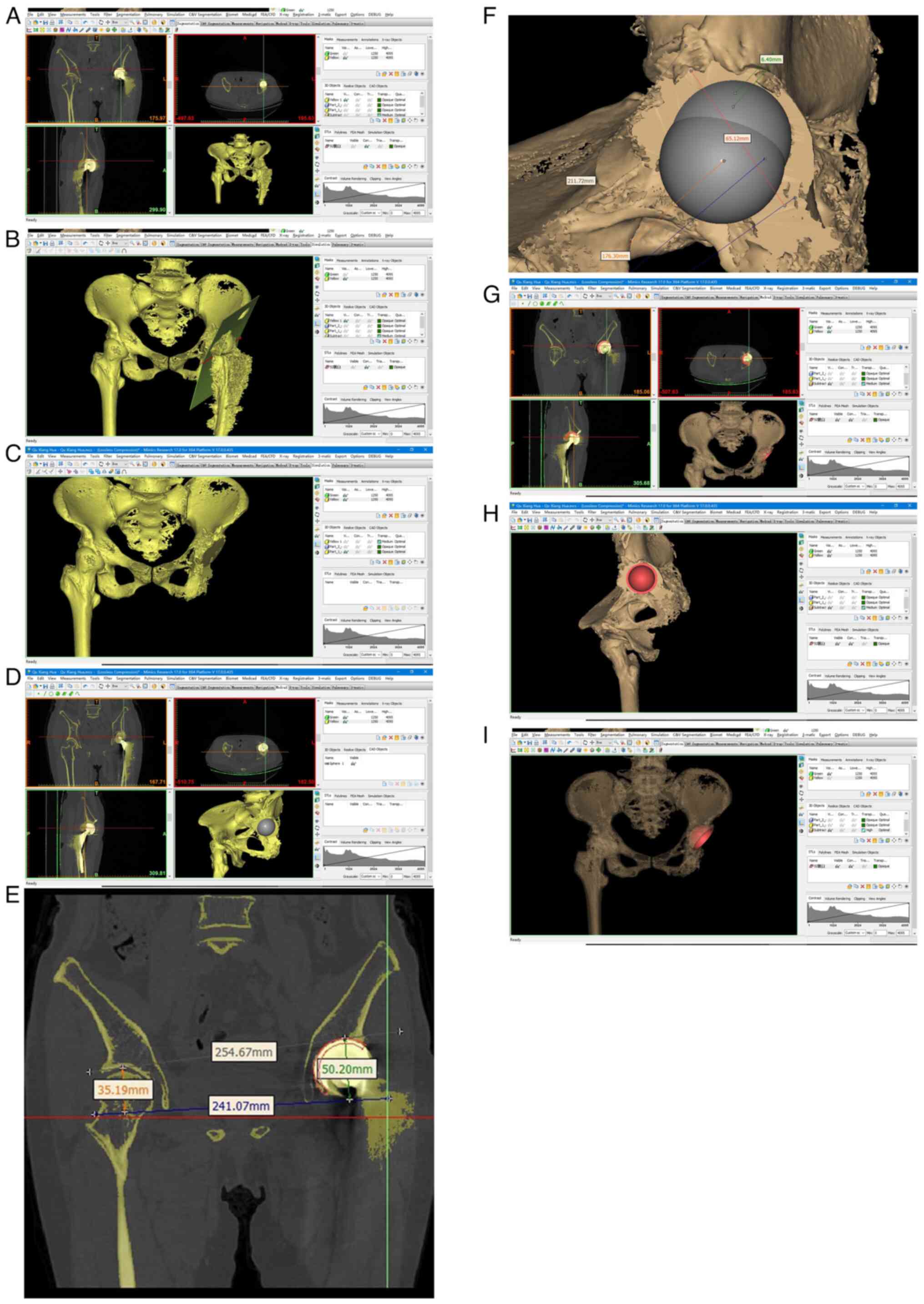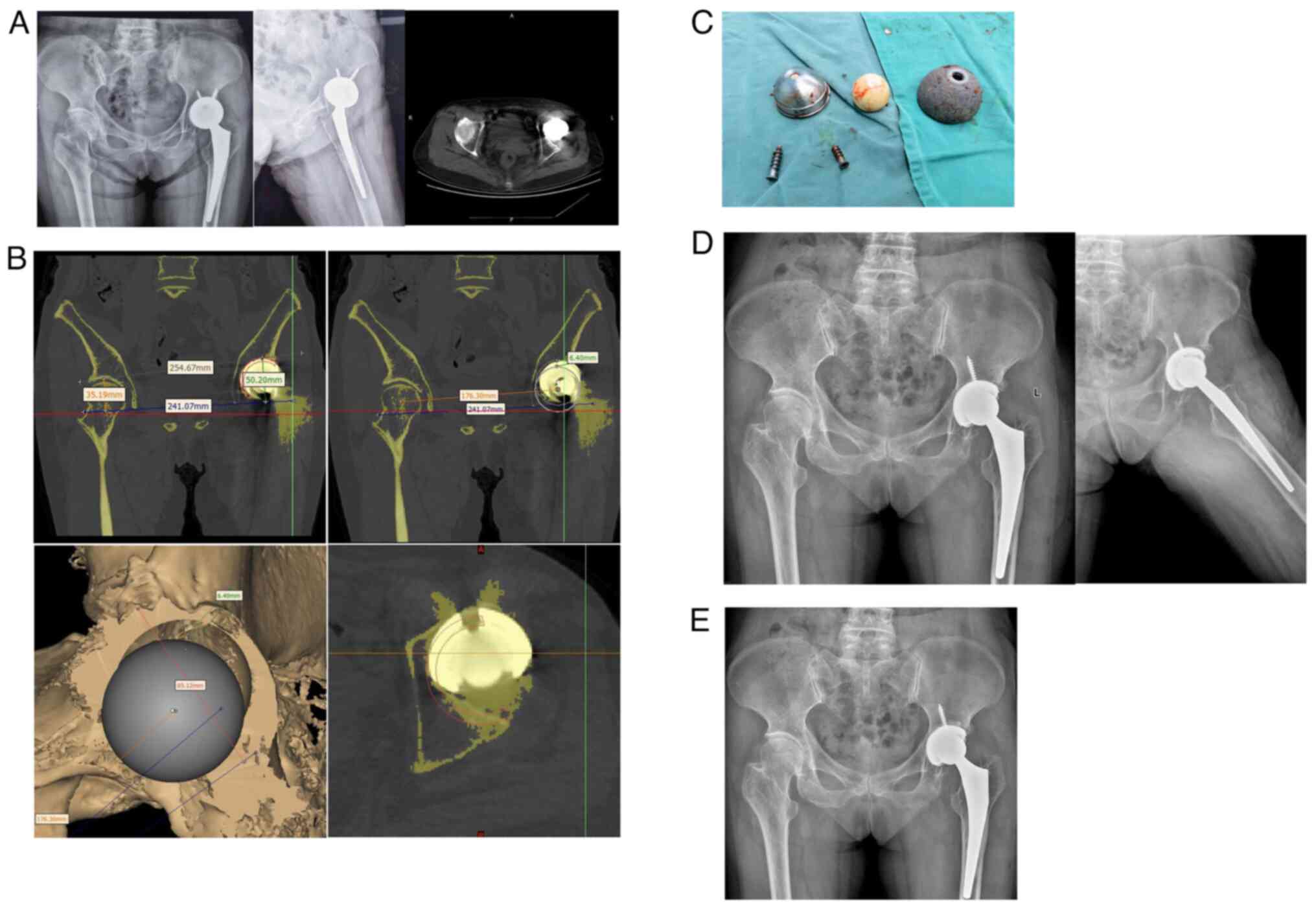|
1
|
Schwartz AM, Farley KX, Guild GN and
Bradbury TL Jr: Projections and epidemiology of revision hip and
knee arthroplasty in the united states to 2030. J Arthroplasty. 35
(Suppl):S79–S85. 2020.PubMed/NCBI View Article : Google Scholar
|
|
2
|
Marsh M and Newman S: Trends and
developments in hip and knee arthroplasty technology. J Rehabil
Assist Technol Eng. 8(2055668320952043)2021.PubMed/NCBI View Article : Google Scholar
|
|
3
|
Darrith B, Courtney PM and Della Valle CJ:
Outcomes of dual mobility components in total hip arthroplasty: A
systematic review of the literature. Bone Joint J. 100-B:11–19.
2018.PubMed/NCBI View Article : Google Scholar
|
|
4
|
Hauer G, Heri A, Klim S, Puchwein P,
Leithner A and Sadoghi P: Survival rate and application number of
total hip arthroplasty in patients with femoral neck fracture: An
analysis of clinical studies and National arthroplasty registers. J
Arthroplasty. 35:1014–1022. 2020.PubMed/NCBI View Article : Google Scholar
|
|
5
|
Larsen JB, Mechlenburg I, Jakobsen SS,
Thilleman TM and Søballe K: 14-year hip survivorship after
periacetabular osteotomy: A follow-up study on 1,385 hips. Acta
Orthop. 91:299–305. 2020.PubMed/NCBI View Article : Google Scholar
|
|
6
|
Kurtz SM, Ong KL, Lau E and Bozic KJ:
Impact of the economic downturn on total joint replacement demand
in the United States: Updated projections to 2021. J Bone Joint
Surg Am. 96:624–630. 2014.PubMed/NCBI View Article : Google Scholar
|
|
7
|
Chapman RM, Van Citters DW, Chapman D and
Dalury DF: Higher offset cross-linked polyethylene acetabular
liners: Is wear a significant clinical concern? Hip Int.
29:652–659. 2019.PubMed/NCBI View Article : Google Scholar
|
|
8
|
Petis SM, Kubista B, Hartzler RU, Abdel MP
and Berry DJ: Polyethylene liner and femoral head exchange in total
hip arthroplasty: Factors associated with long-term success and
failure. J Bone Joint Surg Am. 101:421–428. 2019.PubMed/NCBI View Article : Google Scholar
|
|
9
|
Koob S, Scheidt S, Randau TM, Gathen M,
Wimmer MD, Wirtz DC and Gravius S: Biological downsizing:
Acetabular defect reconstruction in revision total hip
arthroplasty. Orthopade. 46:158–167. 2017.PubMed/NCBI View Article : Google Scholar : (In German).
|
|
10
|
Miettinen HJ, Miettinen SS, Kettunen JS,
Jalkanen J and Kröger H: Revision hip arthroplasty using a porous
tantalum acetabular component. Hip Int. 31:782–788. 2021.PubMed/NCBI View Article : Google Scholar
|
|
11
|
Garcia-Rey E, Saldaña L and
Garcia-Cimbrelo E: Impaction bone grafting in hip re-revision
surgery. Bone Joint J. 103-B:492–499. 2021.PubMed/NCBI View Article : Google Scholar
|
|
12
|
Lewinnek GE, Lewis JL, Tarr R, Compere CL
and Zimmerman JR: Dislocations after total hip-replacement
arthroplasties. J Bone Joint Surg Am. 60:217–220. 1978.PubMed/NCBI
|
|
13
|
Zhou JJ, Zhao M, Liu D, Liu HY and Du CF:
Biomechanical property of a newly designed assembly locking
compression plate: Three-Dimensional finite element analysis. J
Healthc Eng. 2017(8590251)2017.PubMed/NCBI View Article : Google Scholar
|
|
14
|
Shen X, Tian H, Li Y, Zuo J, Gao Z and
Xiao J: Acetabular revision arthroplasty based on 3-Dimensional
reconstruction technology using jumbo cups. Front Bioeng
Biotechnol. 10(799443)2022.PubMed/NCBI View Article : Google Scholar
|
|
15
|
Yang Y, Liao W, Yi W, Jiang H, Fu G, Ma Y
and Zheng Q: Three-dimensional morphological study of the proximal
femur in Crowe type IV developmental dysplasia of the hip. J Orthop
Surg Res. 16(621)2021.PubMed/NCBI View Article : Google Scholar
|
|
16
|
Chen JX, Yu ZY, Cheng QX, Fu MQ, Shi BN,
Yang J, Zhou JJ and Zhao M: Application of personalized digital
analog assisted acetabular prosthesis precise implantation in Crowe
typeⅠand Ⅱhip dysplasia. China J Orthop Trauma. 35:605–609.
2022.PubMed/NCBI View Article : Google Scholar : (In Chinese).
|
|
17
|
Silber DA and Engh CA: Cementless total
hip arthroplasty with femoral head bone grafting for hip dysplasia.
J Arthroplasty. 5:231–240. 1990.PubMed/NCBI View Article : Google Scholar
|
|
18
|
Lakhotia D and Agrawal U: Functional
outcome of uncemented total hip replacement in low socioeconomic
group using modified harris hip score: A prospective midterm
Follow-Up study. Cureus. 15(e50005)2023.PubMed/NCBI View Article : Google Scholar
|
|
19
|
Pradhan R: Planar anteversion of the
acetabular cup as determined from plain anteroposterior
radiographs. J Bone Joint Surg Br. 81:431–435. 1999.PubMed/NCBI View Article : Google Scholar
|
|
20
|
Takemoto N, Nakamura T, Kagawa K,
Maruhashi Y, Sasagawa T, Funaki K, Aikawa T and Yamamoto D:
Clinical outcomes of total hip arthroplasty with the anterolateral
modified Watson-Jones approach for displaced femoral neck
fractures. Geriatr Orthop Surg Rehabil.
13(21514593221134800)2022.PubMed/NCBI View Article : Google Scholar
|
|
21
|
Fröschen FS, Schell S, Wimmer MD,
Hischebeth GTR, Kohlhof H, Gravius S and Randau TM: Synovial
complement factors in patients with periprosthetic joint infection
after undergoing revision arthroplasty of the hip or knee joint.
Diagnostics (Basel). 11(434)2021.PubMed/NCBI View Article : Google Scholar
|
|
22
|
Bondarenko S, Filipenko V, Badnaoui AA,
Ashukina N, Maltseva V, Lazarenko I and Schwarzkopf R:
Periacetabular bone changes after total hip arthroplasty with
highly porous titanium cups in patients with low bone mass. Wiad
Lek. 75:1629–1633. 2022.PubMed/NCBI View Article : Google Scholar
|
|
23
|
Kweon SH, Park JS and Park BH: Sarcopenia
and its association with change of bone mineral density and
functional outcome in old-aged hip arthroplasty patients. Geriatr
Orthop Surg Rehabil. 13(21514593221121377)2022.PubMed/NCBI View Article : Google Scholar
|
|
24
|
Harris WH: The three revolutions in
acetabular revision surgery for total hip replacement: 1. Definite
and 2. Probable. Chir Organi Mov. 88:1–13. 2003.PubMed/NCBI
|
|
25
|
Quinlan ND, Werner BC, Brown TE and Browne
JA: Risk of prosthetic joint infection increases following early
aseptic revision surgery of total hip and knee arthroplasty. J
Arthroplasty. 35:3661–3667. 2020.PubMed/NCBI View Article : Google Scholar
|
|
26
|
Grosso MJ, Kozaily E, Cacciola G and
Parvizi J: Characterizing femoral and acetabular bone loss in
two-stage revision total hip arthroplasty for infection. J
Arthroplasty. 36:311–316. 2021.PubMed/NCBI View Article : Google Scholar
|
|
27
|
Cosyn J, Eghbali A, Hanselaer L, De Rouck
T, Wyn I, Sabzevar MM, Cleymaet R and De Bruyn H: Four modalities
of single implant treatment in the anterior maxilla: A clinical,
radiographic, and aesthetic evaluation. Clin Implant Dent Relat
Res. 15:517–530. 2013.PubMed/NCBI View Article : Google Scholar
|
|
28
|
Chiarlone F, Zanirato A, Cavagnaro L,
Alessio-Mazzola M, Felli L and Burastero G: Acetabular custom-made
implants for severe acetabular bone defect in revision total hip
arthroplasty: A systematic review of the literature. Arch Orthop
Trauma Surg. 140:415–424. 2020.PubMed/NCBI View Article : Google Scholar
|
|
29
|
von Lewinski G: Custom-made acetabular
implants in revision total hip arthroplasty. Orthopade. 49:417–423.
2020.PubMed/NCBI View Article : Google Scholar : (In German).
|
|
30
|
Wirtz DC, Jaenisch M, Osterhaus TA, Gathen
M, Wimmer M, Randau TM, Schildberg FA and Rössler PP: Acetabular
defects in revision hip arthroplasty: A therapy-oriented
classification. Arch Orthop Trauma Surg. 140:815–825.
2020.PubMed/NCBI View Article : Google Scholar
|
|
31
|
Giaretta S, Lunardelli E, Di Benedetto P,
Aprato A, Spolettini P, Mancuso F, Momoli A and Causero A: The
current treatment of hip arthroplasty revision: A systematic review
of the literature. Acta Biomed. 94(e2023092)2023.PubMed/NCBI View Article : Google Scholar
|
|
32
|
Maldonado DR, Go CC, Kyin C, Rosinsky PJ,
Shapira J, Lall AC and Domb BG: Robotic Arm-assisted total hip
arthroplasty is more cost-effective than manual total hip
arthroplasty: A markov model analysis. J Am Acad Orthop Surg.
29:e168–e177. 2021.PubMed/NCBI View Article : Google Scholar
|
|
33
|
Weber M, Witzmann L, Wieding J, Grifka J,
Renkawitz T and Craiovan B: Customized implants for acetabular
Paprosky III defects may be positioned with high accuracy in
revision hip arthroplasty. Int Orthop. 43:2235–2243.
2019.PubMed/NCBI View Article : Google Scholar
|
|
34
|
Myers CA, Huff DN, Mason JB and
Rullkoetter PJ: Effect of intraoperative treatment options on hip
joint stability following total hip arthroplasty. J Orthop Res.
40:604–613. 2022.PubMed/NCBI View Article : Google Scholar
|
|
35
|
Zeng Y, Lai OJ, Shen B, Yang J, Zhou ZK,
Kang PD, Pei FX and Zhou X: Three-dimensional computerized
preoperative planning of total hip arthroplasty with high-riding
dislocation developmental dysplasia of the hip. Orthop Surg.
6:95–102. 2014.PubMed/NCBI View
Article : Google Scholar
|
|
36
|
Sugano N: Computer-assisted orthopaedic
surgery and robotic surgery in total hip arthroplasty. Clin Orthop
Surg. 5:1–9. 2013.PubMed/NCBI View Article : Google Scholar
|
|
37
|
Zhang YZ, Chen B, Lu S, Yang Y, Zhao JM,
Liu R, Li YB and Pei GX: Preliminary application of
computer-assisted patient-specific acetabular navigational template
for total hip arthroplasty in adult single development dysplasia of
the hip. Int J Med Robot. 7:469–474. 2011.PubMed/NCBI View
Article : Google Scholar
|
|
38
|
Wu PH, Liu ZT and Zhang YQ: Pre-clinical
application of self-developed computer assisted design/rapid
prototyping and guidance system to assist precise acetabular
component placement: A pilot study. Chin J Orthop Trauma.
19:323–328. 2017.
|
|
39
|
Li P, Tang H, Liu X, Chen Z, Zhang X, Zhou
Y and Jin Z: Reconstruction of severe acetabular bone defects with
porous metal augment in total hip arthroplasty: A finite element
analysis study. Proc Inst Mech Eng H. 236:179–187. 2022.PubMed/NCBI View Article : Google Scholar
|
|
40
|
Kocak S and Sekercioglu T: Experimental
and numerical static failure analyses of total hip replacement
interfaces. Proc Inst Mech Eng H. 233:1183–1195. 2019.PubMed/NCBI View Article : Google Scholar
|
















